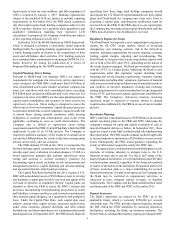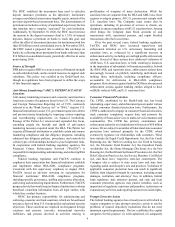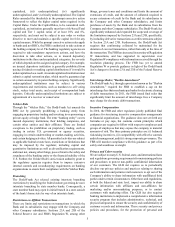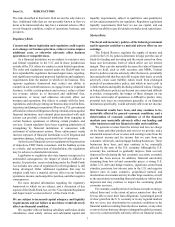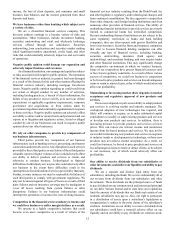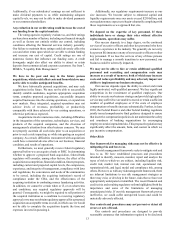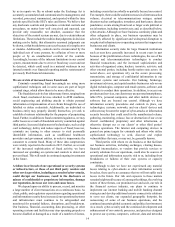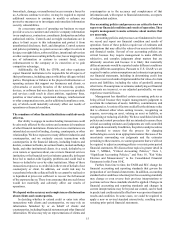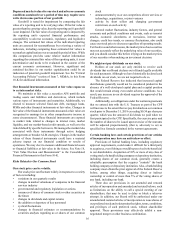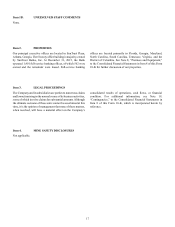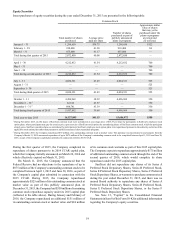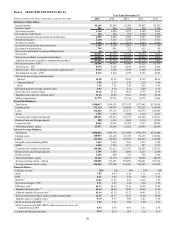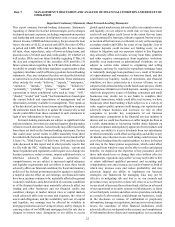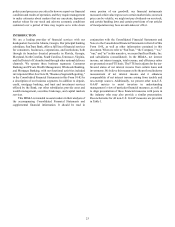SunTrust 2015 Annual Report Download - page 41
Download and view the complete annual report
Please find page 41 of the 2015 SunTrust annual report below. You can navigate through the pages in the report by either clicking on the pages listed below, or by using the keyword search tool below to find specific information within the annual report.13
Additionally, if our subsidiaries' earnings are not sufficient to
make dividend payments to us while maintaining adequate
capital levels, we may not be able to make dividend payments
to our common shareholders.
Any reduction in our credit rating could increase the cost of
our funding from the capital markets.
The rating agencies regularly evaluate us, and their ratings
are based on a number of factors, including our financial strength
as well as factors not entirely within our control, including
conditions affecting the financial services industry generally.
Our failure to maintain those ratings could adversely affect the
cost and other terms upon which we are able to obtain funding
and increase our cost of capital. Credit ratings are one of
numerous factors that influence our funding costs. A credit
downgrade might also affect our ability to attract or retain
deposits from commercial and corporate customers. See Item 7,
MD&A, "Liquidity Risk Management.”
We have in the past and may in the future pursue
acquisitions, which could affect costs and from which we may
not be able to realize anticipated benefits.
We have historically pursued acquisitions, and may seek
acquisitions in the future. We may not be able to successfully
identify suitable candidates, negotiate appropriate acquisition
terms, complete proposed acquisitions, successfully integrate
acquired businesses into the existing operations, or expand into
new markets. Once integrated, acquired operations may not
achieve levels of revenues, profitability, or productivity
comparable with those achieved by our existing operations, or
otherwise perform as expected.
Acquisitions involve numerous risks, including difficulties
in the integration of the operations, technologies, services, and
products of the acquired companies, and the diversion of
management's attention from other business concerns. We may
not properly ascertain all such risks prior to an acquisition or
prior to such a risk impacting us while integrating an acquired
company. As a result, difficulties encountered with acquisitions
could have a material adverse effect on our business, financial
condition, and results of operations.
Furthermore, we must generally receive federal regulatory
approval before we can acquire a bank or BHC. In determining
whether to approve a proposed bank acquisition, federal bank
regulators will consider, among other factors, the effect of the
acquisition on competition, financial condition, future prospects,
including current and projected capital levels, the competence,
experience, and integrity of management, compliance with laws
and regulations, the convenience and needs of the communities
to be served, including the acquiring institution's record of
compliance under the CRA, and the effectiveness of the
acquiring institution in combating money laundering activities.
In addition, we cannot be certain when or if, or on what terms
and conditions, any required regulatory approvals will be
granted. Consequently, we might be required to sell portions of
the acquired institution as a condition to receiving regulatory
approval or we may not obtain regulatory approval for a proposed
acquisition on acceptable terms or at all, in which case we would
not be able to complete the acquisition despite the time and
expenses invested in pursuing it.
Additionally, our regulatory requirements increase as our
size increases. We become subject to enhanced capital and
liquidity requirements once our assets exceed $250 billion, and
our regulators may expect us to begin voluntarily complying with
those requirements as we approach that size.
We depend on the expertise of key personnel. If these
individuals leave or change their roles without effective
replacements, operations may suffer.
Our success depends, to a large degree, on the continued
services of executive officers and other key personnel who have
extensive experience in the industry. We generally do not carry
key person life insurance on any of our executive officers or other
key personnel. If we lose the services of any of these persons
and fail to manage a smooth transition to new personnel, our
business could be adversely impacted.
We may not be able to hire or retain additional qualified
personnel and recruiting and compensation costs may
increase as a result of turnover, both of which may increase
costs and reduce profitability and may adversely impact our
ability to implement our business strategies.
Our success depends upon the ability to attract and retain
highly motivated, well-qualified personnel. We face significant
competition in the recruitment of qualified employees. Our
ability to execute our business strategy and provide high quality
service may suffer if we are unable to recruit or retain a sufficient
number of qualified employees or if the costs of employee
compensation or benefits increase substantially. Further, in June
2010, the Federal Reserve and other federal banking regulators
jointly issued comprehensive final guidance designed to ensure
that incentive compensation policies do not undermine the safety
and soundness of banking organizations by encouraging
employees to take imprudent risks. This proposed regulation may
significantly affect the amount, form, and context in which we
pay incentive compensation.
Other Risks
Our framework for managing risks may not be effective in
mitigating risk and loss to us.
Our risk management framework seeks to mitigate risk and
loss to us. We have established processes and procedures
intended to identify, measure, monitor, report and analyze the
types of risk to which we are subject, including liquidity risk,
credit risk, market risk, interest rate risk, operational risk,
reputational risk, and legal, model and compliance risk, among
others. However, as with any risk management framework, there
are inherent limitations to our risk management strategies as
there may exist, or develop in the future, risks that we have not
appropriately anticipated or identified. The recent financial and
credit crisis and resulting regulatory reform highlighted both the
importance and some of the limitations of managing
unanticipated risks. If our risk management framework proves
ineffective, we could suffer unexpected losses and could be
materially adversely affected.
Our controls and procedures may not prevent or detect all
errors or acts of fraud.
Our controls and procedures are designed to provide
reasonable assurance that information required to be disclosed


